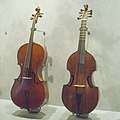Pegbox


The peg box is a component in various plucked and bowed instruments , which the eddy receives. The pegs can be simple conical wooden pegs or tuning machines .
The pegbox is attached to the neck of the instrument or is made in one piece with the neck. It is usually angled backwards opposite the neck so that the strings are stretched over the saddle at a certain angle and with pressure .
Working principle
The pegbox represents an improvement on the principle of inserting vertebrae in front or side into holes in the extension of the neck, as is still the case today with the Indian tanpura or the Turkish saz . In the pegbox, the pegs are fed through two drill holes. The string is attached to the peg in the area in between and wound up. This storage is more stable and improves handling when tuning.
The headstock serves the same purpose as the pegbox on guitars and related instruments (see more on this below). There are also other ways in which the strings can be attached or tuned to the head of the instrument with pegs or mechanics, for example on the Portuguese guitar or on instruments from non-European cultural areas.
Designs
The basic shape of the pegbox is that of an elongated box shape with bottom and side walls, open at the top. The bottom can also be missing, the pegbox then has a frame or window shape. The pegs, or the adjustment axes of the mechanics, are located transversely in the box and are guided through conical holes through the sides of the peg box. The vortex heads are usually arranged alternately left and right, which creates more space to rotate them. In the case of the window vortex box with a central bar, two adjusting axes are arranged at the same height.
The design of the pegbox is not necessarily tied to one type of instrument. In the area of lutes, mandolins and cistern in particular, different versions can be found depending on the age and origin of the instrument. The following only indicates which designs are common or typical for which instruments:
- Pegbox with scroll : violin , viola , violoncello , double bass and the viola da gamba family
- Trapezoidal pegbox, typically relatively strongly angled: oud , lute
- Peg box with carved head (e.g. human or animal head): violin, viola da gamba, cister
- Pegbox with hook-shaped head, mostly ending in a plate: baroque mandolin , guitar lute
The essay of the pegbox, z. B. as a snail or head, has a predominantly decorative function and only a small influence on the sound of the instrument.
Examples
Large pegbox for 14 strings on a viola d'amore from 1643
Trapezoidal peg box a Renaissance lute ( buckling lute )
Pegbox and headstock
The flat headstock, as can be found on guitars, mandolas , mandolins , banjos and other instruments, initially fulfills the same purpose as a pegbox, it is used to attach the pegs for tensioning and tuning the strings on the head of the instrument. The flat headstock has already been used at the Spanish Vihuela , among others . The fiddle also had a similar pegboard.
Before the invention of the tuning mechanism, the wooden pegs were inserted from behind through holes in the headstock. When the tuning mechanics later prevailed, they wanted to keep the backward pegs on the guitar. The double-slotted window head plate of the concert guitar was developed from this, which, with its transverse positioning axes, represents a technical middle thing between a window pegbox and the head plate. For modern guitars with steel strings, in particular the western guitar , the electric guitar and the electric bass , however, one returned to the original principle of the positioning axes inserted vertically through the plate, whereby the wings now became lateral.







